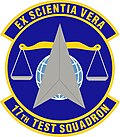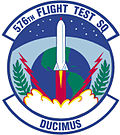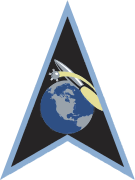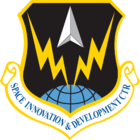Space Training and Readiness Command
| Space Training and Readiness Command | |
|---|---|
 Space Training and Readiness Command emblem | |
| Founded | 23 August 2021 (2 years, 7 months) as Space Training and Readiness Command 1 November 1993 (30 years, 5 months) as the Space Warfare Center Field command |
| Role | |
| Size | 800 personnel CMSgt Karmann-Monique Pogue[3] |
| Insignia | |
| Flag |  |
Space Training and Readiness Command (STAR Command or STARCOM) is the
Space Training and Readiness Command was first established on 1 November 1993 as the U.S. Air Force Space Warfare Center under
History
Beginning as the Space Warfare Center
-
595th Space Group
-
3rd Space Experimentation Squadron
-
17th Test Squadron
-
Air Force Space Battlelab
The U.S. Air Force Space Warfare Center (SWC) was established on 1 November 1993 at
The Space Warfare Center was specifically tasked with integrating space forces with terrestrial forces, including working with the
On 7 April 2000, the Space Warfare Center gained the
On 1 March 2006, the Space Warfare Center was redesignated as the Space Innovation and Development Center (SIDC). As part of this change, the 25th Space Range Squadron and 527th Space Aggressor Squadron were scheduled to be transferred to
On 1 April 2013, the Space Innovation and Development Center, along with the 595th Space Group, were inactivated. The 3rd Space Experimentation Squadron was reassigned the 50th Space Wing. The remaining units were transferred to Air Combat Command, with the 17th Test Squadron becoming part of the 53rd Test Management Group and the 25th Space Range Squadron becoming part of the Nevada Test and Training Range.[17]
Resurrection as Space Training and Readiness Command

The first mention of STARCOM during planning for the Space Force was in a 18 March 2019 briefing given by Task Force Tango, a planning group within Air Force Space Command and its mission was finalized later that year.[18] In December 2020, the Space Training and Readiness Command Task Force was created, with Brigadier General Shawn Bratton, an Air National Guard officer, serving as planning lead and Chief Master Sergeant James P. Seballes senior enlisted leader.[19][20]
The creation of STARCOM was announced on 30 June 2020 as one of three
On 23 August 2021, STARCOM was activated as the Space Force's first field command following the inactivation of STAR Delta (P). Brigadier General Shawn Bratton took command as the first commander of STARCOM and Chief Master Sergeant Seballes became its first senior enlisted leader. Following the activation of STARCOM, five subordinate
In May 2023, the Department of the Air Force announced that Space Training and Readiness Command's permanent home would be Patrick Space Force Base, Florida. It also announced that Space Delta 10 would also be moving from the U.S. Air Force Academy to Patrick SFB, Space Delta 11 would move from Schriever SFB to Kirtland Air Force Base, and that Space Delta 12 would stay at Schriever SFB.[23]
Symbolism
-
Space Training and Readiness Command (2021–present)
-
Space Training and Readiness Delta (Provisional) (2020–2021)
-
Space Innovation and Development Center and Space Warfare Center (1993–2013)
Structure
STARCOM is composed of five
| Delta | Function | Headquarters | Current Commander | |
|---|---|---|---|---|
 |
Space Delta 1 | Space training | Vandenberg Space Force Base, California | Col Jason N. Schramm |
 |
Space Delta 10 | Space wargaming |
United States Air Force Academy, Colorado* | Col Jack D. Fulmer II |
 |
Space Delta 11 | Space range and aggressor | Schriever Space Force Base, Colorado* | Col Jay M. Steingold |
 |
Space Delta 12 | Space test and evaluation | Schriever Space Force Base, Colorado* | Col E. Lincoln Bonner III |
 |
Space Delta 13 | Space education | Maxwell Air Force Base, Alabama* | Col Niki J. Lindhorst |
List of commanders
| No. | Commander | Term | |||
|---|---|---|---|---|---|
| Portrait | Name | Took office | Left office | Term length | |
| 1 | Major General Shawn Bratton | 23 August 2021 | 20 July 2023 | 1 year, 331 days | |
| 2 | Major General Timothy Sejba | 20 July 2023 | Incumbent | 273 days | |
See also
U.S. Armed Forces training and education commands
- Army Training and Doctrine Command
- Marine Corps Training and Education Command
- Naval Education and Training Command
- Air Education and Training Command
References
- ^ a b c d e "Space Training and Readiness Command (USSF)". Air Force Historical Research Agency. 3 January 2022. Archived from the original on 19 January 2022.
- ^ a b "Raymond: New STARCOM Will 'Shape the Next Century' of Space Operations". 23 August 2021.
- ^ "Karmann-Monique Pogue".
- ^ "USSF names STARCOM as lead Operational Test Agency". Space Training and Readiness Command (STARCOM). 15 December 2023.
- ^ a b c d "Space Force activates Space Training and Readiness Command". United States Space Force. 23 August 2021.
- ^ a b "USSF field command structure reduces command layers, focuses on space warfighter needs". United States Space Force. 30 June 2020. Archived from the original on 8 April 2021. Retrieved 19 July 2020.
- ^ "30th Anniversary Milestone: AFSPC Space Warfare Center (SWC) activated at Falcon AFB, Colo". Air Force Space Command. 7 November 2012. Archived from the original on 6 February 2022.
- ^ "The Fight for Space".
- ^ "30th Anniversary Milestone: Space Warfare Center (SWC) reredesignated the Space Innovation and Development Center (SIDC)". Air Force Space Command. 1 March 2013. Archived from the original on 17 April 2022.
- ^ Lovelace, Airman Amanda (11 February 2020). "17th Test Squadron executes one of a kind mission". 50th Space Wing Public Affairs. Archived from the original on 6 February 2022.
- Air & Space Forces Magazine. Archivedfrom the original on 30 October 2022.
- ^ "595 Command and Control Group (AFSPC)". Air Force Historical Research Agency. Archived from the original on 8 December 2021.
- ^ "National Security Space Institute (AFSPC)".
- ^ "What's in a name? SWC becomes SIDC".
- ^ "Space Battlelab stands down after 10 years".
- ^ "576th Flight Test Squadron". Air Force Global Strike Command AFSTRAT-AIR. August 2018. Archived from the original on 23 March 2022.
- ^ "Schriever: A brief history".
- ^ "Q&A: Meet STARCOM's First Historian". Space Training and Readiness Command (STARCOM). 4 February 2022. Archived from the original on 6 February 2022.
- ^ "Space Force to establish new command in Colorado focused on training and education". 20 August 2021.
- ^ "Chief Master Sergeant James P. Seballes" (PDF). United States Space Force. August 2021. Archived (PDF) from the original on 6 February 2022.
- ^ "Space Force Finalizes Organizational Changes". 30 June 2020. Archived from the original on 16 July 2020. Retrieved 19 July 2020.
- ^ "USSF Virtual Activation & Deactivation Ceremonies". DVIDS. Archived from the original on 18 August 2021. Retrieved 20 August 2021.
- ^ "Space Force's STARCOM HQ Preferred Location is Florida Base, Service Says". 31 May 2023.
- ^ "Who We Are". www.starcom.spaceforce.mil. United States Space Force. Retrieved 7 February 2022.
 This article incorporates text from this source, which is in the public domain.
This article incorporates text from this source, which is in the public domain.
- ^ "Space Training and Readiness Command Emblem Explainer".
- ^ "How We Do It". www.starcom.spaceforce.mil.














